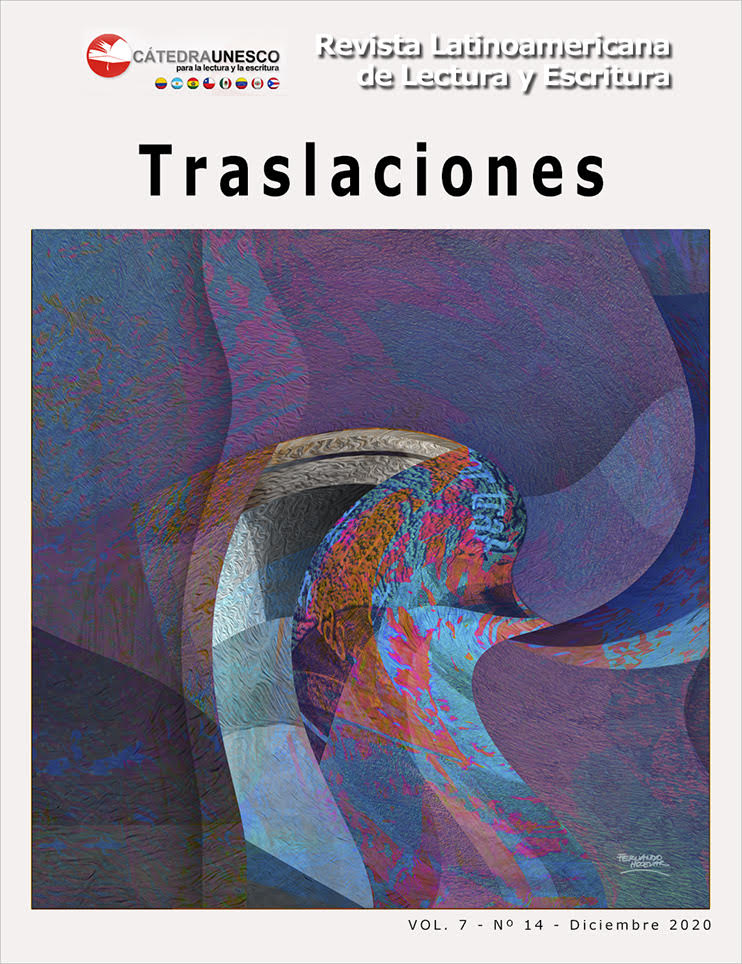Disputas, justificaciones y posturas éticas de niños bilingües quechua-español en Bolivia
DOI:
https://doi.org/10.48162/rev.5.011Palabras clave:
Recursos discursivos, Toma de postura, Disponibilidad ética, Socialización a través del lenguaje, JustificacionesResumen
Este estudio examina la construcción y la función de las justificaciones en el marco de las disputas que se llevan a cabo entre niños y niñas bilingües del quechua y del español bolivianos en dos comunidades rurales de Bolivia, T’ojlu Rancho y San Isidro, en el departamento de Cochabamba. Enmarcado en el enfoque de la socialización en y para el lenguaje, el estudio adopta el método etnográfico mediante la recolección de datos interactivos espontáneos, el registro video, el análisis conversacional y la multimodalidad. Los datos interactivos analizados se enfocan en secuencias opositivas de niñas y niños de entre 3 y 9 años de edad, en espacios del hogar, la comunidad y la escuela. Los resultados muestran la conexión de las justificaciones con la emergencia de la persona mediante, en parte, las posturas y disponibilidades éticas de la niñez de la región, que van desde la adopción de posturas polarizadas hasta intermedias, según la interpretación y la elección de normas sociales realizadas. Así también, estos resultados exponen las maneras como la niñez de la región puede construir las justificaciones mediante un uso estratégico de autorías atribuidas a las normas sociales, además de defender e intentar legitimar posturas mediante recursos discursivos creativamente utilizados: por ejemplo, el cambio de código.
Descargas
Citas
Bergmann, J. (1998). Introduction: Morality in Discourse. Research on Language and Social Interaction, 31(3/4), 279-294.
Cekaite, A.; Blum-Kulka, S.; Grøver, V. & Teubal, E. (2014). Children’s peer talk and learning: uniting discursive, social, and cultural facets of peer interactions: editors’ introduction. In A. Cekaite, S. Blum-Kulka, V. Grøver & E. Teubal, E. (Eds.), Children's peer talk. Learning from each other (pp. 3-20). Cambridge University Press.
Cortina, A. & Martínez, E. (2001). Ética. Akal.
Cortina, A. (2013). ¿Para qué sirve realmente la ética? Paidós.
Church, A. (2009). Preference Organisation and Peer Disputes. How Young Children Resolve Conflict. Ashgate Publishing Limited.
Comparini, L. (2000). Constructing self and other: A language socialization approach to Latina mother-child conflict talk. Clark University
Corsaro, W. (2011). The Sociology of Childhood. Pine Forge Press.
Cromdal, J. (2004). Building bilingual oppositions: Code-switching in children’s disputes. Language in Society, 33 (1), 33-58. DOI: 10. 1017/S0047404504031021
Cromdal, J. & Aronsson, K. (2000). Footing in bilingual play. Journal of Sociolinguistics 4(3), 435–457.
Danby, S. & Theobald, M. (2012). Introduction: Disputes in Everyday Life - Social and Moral Orders of Children and Young People. En S. Danby & M. Theobald (Eds.), Disputes in Everyday Life: Social and Moral Orders of Children and Young People (pp. xv-xxiv). Emerald.
De León, L. (2012). Language Socialization and Multiparty Participation Frameworks. En A. Duranti, E. Ochs, & B. Schieffelin (Eds.), The Handbook of Language Socialization (pp. 81–112). Blackwell Publishing Ltd.
De León, L. (2010). Socialización, lenguajes y culturas infantiles: estudios interdisciplinarios. CIESAS.
De León, L. (2005). La llegada del alma. Lenguaje, infancia y socialización entre los mayas de Zinacantán. CIESAS, CONACULTA, INAH.
Du Bois, J. (2007). The stance triangle. En R. Englebretson (Ed.), Stancetaking in Discourse: Subjectivity, Evaluation, Interaction (pp. 139–182). John Benjamins Publishing Company.
Eisenberg, A.R. & Garvey, C. (1981). Children's use of verbal strategies in resolving conflicts. Discourse Processes, 4(2), 149-170.
Englebretson, R. (Ed.). (2007). Stancetaking in Discourse. Amsterdam/Philadelphia: John Benjamins. Pragmatics & Beyond New Series 164.
Fader, A. (2011). Language Socialization and Morality. En A. Duranti, E. Ochs y B. Schieffelin (Eds), The Handbook of Language Socialization, First Edition (322-340). Blackwell Publishing Ltd.
Garrett, P. (2007). Language Socialization and the (Re)Production of Bilingual Subjectivities. En M. Heller (Ed.), Bilingualism: A Social Approach (pp. 233–56). Palgrave Macmillan.
Garvey, C., & Shantz, C.U. (1992). Conflict talk: Approaches to adversative discourse. In C.U. Shantz & W.W. Hartup (Eds.), Conflict in child and adolescent development (pp. 93–121). Cambridge University Press.
Goffman, E. (1967). Interaction Ritual: Essays on Face-to-Face Behavior. Anchor Books.
Goodwin, M. H. (1990). He-Said-She-Said. Talk as Social Organization Among Black Children. Indiana University Press.
Goodwin, M. H. (2002a). Building power asymmetries in girls’ interaction. Discourse & Society 13(6), 715–730.
Goodwin, M. H. (2002b). Exclusion in Girls’ Peer Groups: Ethnographic Analysis of Language Practices on the Playground. Human Development 45(6), 392–415.
Goodwin, C. (2003). Pointing as Situated Practice. En S. Kita (Ed.), Pointing: Where Language, Culture and Cognition Meet (pp. 17–41). Lawrence Erlbaum.
Goodwin, M. H., & Kyratzis, A. (2012). Peer Language Socialization. En A. Duranti, E. Ochs, & B. Schieffelin (Eds.), The Handbook of Language Socialization (pp. 365–390). Blackwell Publishing Ltd.
Goodwin, M. H. (2016). Haptic sociality: the embodied interactive construction of intimacy through touch. In C. Meyer, J. Streeck, J. Scott Jordan (Eds.), Intercorporeality: Beyond the Body. Oxford University Press (in press).
Jaffe, A. (2009). Introduction: The Sociolinguistic of Stance. En A. Jaffe (Ed.), Stance: Sociolinguistic Perspectives (3-28). Oxford University Press.
Jefferson, G. (1973). A case or precision timing in ordinary conversation: overlapped tag position address terms in closing sequences. Semiotica 9, 47-96.
Keane, W. (2015). Ethical Life. Its Natural and Social Histories. Princeton University Press.
Kyratzis, A.; Tang, Y. T. & Bahar, K. (2009). Codes, code-switching and context: Style and footing in peer group bilingual play. Walter de Gruyter, Multilingua 28, 265–290.
Maynard, D. W. (1985). How children start arguments. Language in Society 14, 1–30.
Miller, P. & Sperry, L. (1987). The socialization of Anger and Aggression. Merril-Palmer Quarterly 33, 1–33.
Ochs, E. (1996). Linguistic resources for socializing humanity. En J. Gumperz & S. Levinson (Eds.). Rethingking linguistic relativity. Studies in the Social and Cultural of Language, 17 (pp. 407-437). Cambridge University Press.
Ochs, E. (1988). Culture and language development.Language acquisition and language socialization in a Samoan village. Cambridge University Press.
Ochs, E. & Schieffelin, B (2012). The Theory of Language Socialization. En A. Duranti, E. Ochs, & B. Schieffelin (Eds.). The Handbook of Language Socialization (pp.1-22). Blackwell Publishing Ltd.
Paugh, A. (2012). Playing with Languages. Children and Change in a Caribbean Village. Berghan Books.
Paugh, A. (2005). Multilingual play: Children's code switching, role play, and agency in Dominica, West Indies. Language in Society, 34, 63-86.
Sacks, H.; Schegloff, E. A. & Jefferson, G. (1974). A Simplest Systematics for the Organization of Turn-Taking for Conversation. Language, 50 (4), 696–735.
Savater, F. (1991). Ética para Amador. Editorial Ariel S.A.
Stivers, T. & Sidnell, J. (2005). Multimodal interaction. Special issue. Semiotica 156 (1/4).
Terceros, C. (2017). Disputas, lenguaje y ética infantil: un estudio de la socialización entre los niños de T’ojlu Rancho y San Isidro en Cochabamba, Bolivia. CIESAS, Tesis de doctorado.
Zentella, A. C. (1997). Growing Up Bilingual. Blackwell Publishers.
Descargas
Publicado
Cómo citar
Número
Sección
Licencia
Derechos de autor 2020 Carmen Terceros

Esta obra está bajo una licencia internacional Creative Commons Atribución-NoComercial-SinDerivadas 4.0.
- Los autores/as conservarán sus derechos de autor y garantizarán a la revista el derecho de primera publicación de su obra, el cuál estará simultáneamente sujeto a la Licencia de reconocimiento de Creative Commons que permite a terceros compartir la obra siempre que se indique su autor y su primera publicación esta revista.
- Los autores/as podrán adoptar otros acuerdos de licencia no exclusiva de distribución de la versión de la obra publicada (p. ej.: depositarla en un archivo telemático institucional o publicarla en un volumen monográfico) siempre que se indique la publicación inicial en esta revista.
- Se permite y recomienda a los autores/as difundir su obra a través de Internet (p. ej.: en archivos telemáticos institucionales o en su página web) antes y durante el proceso de envío, lo cual puede producir intercambios interesantes y aumentar las citas de la obra publicada. (Véase El efecto del acceso abierto).





